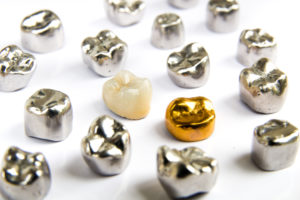
Metals in dentistry are used to create a variety of restorations, from fillings and crowns to bridges and dental implants. Not all metals are created equal. Some are biocompatible, which means they aren’t harmful to living tissue. In contrast, some metals can be detrimental to health over time. Here, we’ll explore some of the most common metals in dentistry and discuss their properties.
Base, Noble, and High-Noble Metals in Dentistry
The American Dental Association classifies alloys into three categories:
- Base metals: Base metal alloys, principally made of nickel, chromium, copper, zinc, and beryllium have gained widespread usage due to their lower cost and high strength. In dentistry, silver is also considered a base metal. It’s important to note that silver in its purest form is not used in dentistry.
- Noble metals: These alloys include palladium, platinum, ruthenium, rhodium, and iridium. They may also include gold but contain less than high noble metals.
- High noble metals: High noble alloys have a higher gold and platinum content. These alloys cost more but are more biocompatible and fit better. Due to the higher cost to produce, these alloys are less commonly used by dentists but they produce the safest and longest lasting dental restorations.
Silver Amalgam
Traditional dental fillings are made from silver amalgam. This material is a mixture of tin, copper, silver, zinc, and inorganic mercury. Many patients avoid amalgam due to perceived toxicity from the mercury content. As of this time, no double blind study has ever shown silver fillings to be harmful.
Many dentists still place amalgam fillings due to their low cost or if nothing else will work. Composite fillings, which are fairly biocompatible and an aesthetically pleasing, have become the dominant filling material. It has become a more popular choice.
Stainless Steel
Stainless steel alloy is commonly used to make short term dental crowns. These restorations are primarily used on baby teeth or on permanent teeth as a temporary measure. Stainless steel used in dentistry is medical grade, meaning it is fairly tissue friendly.
Stainless steel restorations are not generally recommended for permanent use. They are mass produced in a limited number of shapes. The “one size fits all” shapes do not allow enough customization to seal the restoration for the long term.
Nickel Chromium
Nickel chromium is a strong base metal alloy used in the fabrication of dental restorations. Several case studies have linked nickel chromium to hypersensitivity. Research is ongoing in this field, but some studies suggest that nickel chromium could cause toxicity if absorbed in large quantities. Therefore, this base alloy is not considered biocompatible. Crowns made cheaply in China often contain this toxic alloy.
Cobalt Chromium
Like nickel chromium, cobalt chromium is used in dentistry because it’s strong, durable, and corrosion resistant. This base dental alloy also bonds well to porcelain, making it a common choice for PFM crowns. This is the most commonly used metal alloy due to it’s low cost.
There are several different types of cobalt chromium alloys – upwards of 30, in fact. To determine the long term safety and biocompatibility of this alloy, more research is necessary. Cobalt chrome does not cast as well as noble or high noble alloys so the fit is not as good.
Titanium
Titanium is considered one of the most biocompatible metals in dentistry and in the medical field at large. It’s strong and resilient, able to withstand the body’s harsh environment. Titanium is also resistant to corrosion and can fuse directly to the bone tissue – a process known as osseointegration. For this reason, it is the most common material used in the fabrication of dental implants.
Titanium allergic reactions are almost unheard of in the dental field. However, there is a very small percentage of the population with titanium hypersensitivity. These individuals may not be candidates for titanium implants. In these instances, ceramic implants can be placed instead.
Nickel Titanium
Nickel titanium boasts unique physical properties of shape memory and superelasticity. This means that the alloy returns to its original shape once force is removed. This kind of strength is ideal for dental applications such as orthodontic wiring.
Nickel titanium is also commonly used to manufacture endodontic drills for root canal procedures. This metal alloy is considered biocompatible.
Gold Alloy
Gold is the “golden standard” when it comes to metals in dentistry. It is biocompatible – and because of its soft composition a gold crown or onlay will not damage the opposing teeth. There are no metal allergies to precious, high carat gold or platinum.
Learn more about the types of metals in dentistry
While high noble metals are more expensive than base metal alloys, restorations made from precious metals fit better and last longer. Most dentists do not share the quality level of the metals they use in their dental work. Generally, dental fees are related to the time, talent, and material costs of the restorations.
If you have a dental cavity or need a dental restoration, talk to your dentist about which materials and alloy types are best for a long lasting, healthy smile.
